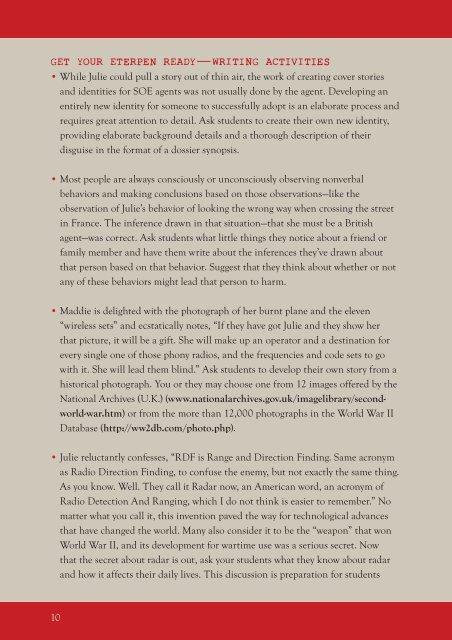Download the complete discussion/teacher's guide - BookBrowse
Download the complete discussion/teacher's guide - BookBrowse
Download the complete discussion/teacher's guide - BookBrowse
Create successful ePaper yourself
Turn your PDF publications into a flip-book with our unique Google optimized e-Paper software.
get your eterpEn ready—writing activities<br />
• While Julie could pull a story out of thin air, <strong>the</strong> work of creating cover stories<br />
and identities for SOE agents was not usually done by <strong>the</strong> agent. Developing an<br />
entirely new identity for someone to successfully adopt is an elaborate process and<br />
requires great attention to detail. Ask students to create <strong>the</strong>ir own new identity,<br />
providing elaborate background details and a thorough description of <strong>the</strong>ir<br />
disguise in <strong>the</strong> format of a dossier synopsis.<br />
• Most people are always consciously or unconsciously observing nonverbal<br />
behaviors and making conclusions based on those observations—like <strong>the</strong><br />
observation of Julie’s behavior of looking <strong>the</strong> wrong way when crossing <strong>the</strong> street<br />
in France. The inference drawn in that situation—that she must be a British<br />
agent—was correct. Ask students what little things <strong>the</strong>y notice about a friend or<br />
family member and have <strong>the</strong>m write about <strong>the</strong> inferences <strong>the</strong>y’ve drawn about<br />
that person based on that behavior. Suggest that <strong>the</strong>y think about whe<strong>the</strong>r or not<br />
any of <strong>the</strong>se behaviors might lead that person to harm.<br />
• Maddie is delighted with <strong>the</strong> photograph of her burnt plane and <strong>the</strong> eleven<br />
“wireless sets” and ecstatically notes, “If <strong>the</strong>y have got Julie and <strong>the</strong>y show her<br />
that picture, it will be a gift. She will make up an operator and a destination for<br />
every single one of those phony radios, and <strong>the</strong> frequencies and code sets to go<br />
with it. She will lead <strong>the</strong>m blind.” Ask students to develop <strong>the</strong>ir own story from a<br />
historical photograph. You or <strong>the</strong>y may choose one from 12 images offered by <strong>the</strong><br />
National Archives (U.K.) (www.nationalarchives.gov.uk/imagelibrary/secondworld-war.htm)<br />
or from <strong>the</strong> more than 12,000 photographs in <strong>the</strong> World War II<br />
Database (http://ww2db.com/photo.php).<br />
• Julie reluctantly confesses, “RDF is Range and Direction Finding. Same acronym<br />
as Radio Direction Finding, to confuse <strong>the</strong> enemy, but not exactly <strong>the</strong> same thing.<br />
As you know. Well. They call it Radar now, an American word, an acronym of<br />
Radio Detection And Ranging, which I do not think is easier to remember.” No<br />
matter what you call it, this invention paved <strong>the</strong> way for technological advances<br />
that have changed <strong>the</strong> world. Many also consider it to be <strong>the</strong> “weapon” that won<br />
World War II, and its development for wartime use was a serious secret. Now<br />
that <strong>the</strong> secret about radar is out, ask your students what <strong>the</strong>y know about radar<br />
and how it affects <strong>the</strong>ir daily lives. This <strong>discussion</strong> is preparation for students<br />
10


